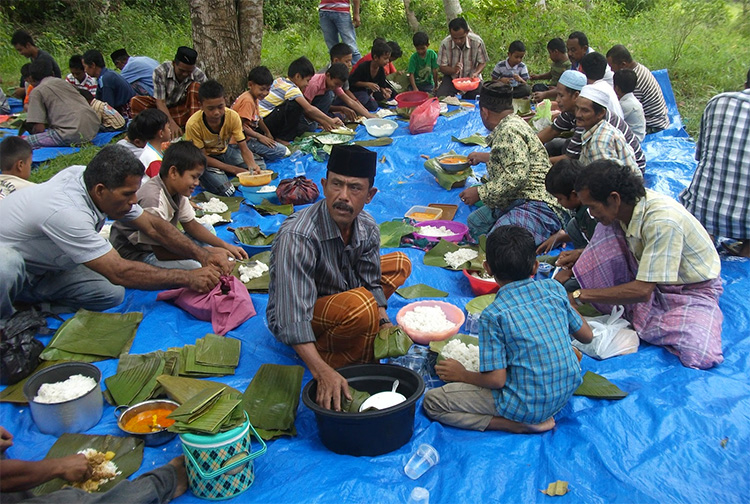Indonesian community in their daily life is largely affected by their spiritual consciousness. They always believe in having special relation with the nature.
Traditional ceremony is a form of traditions still implemented until now. It is a mean to remind the people of their existence and their relation to the environment. Until now, the existence of these traditional ceremonies are acknowledged and implemented well. Even though the forms and the methods are different regionally.
Traditional ceremony system, related closely to the religious aspect of community, is known as kenduri. Kenduri is a traditional ceremony in a form of gathering to pray to the Almighty. They beg to ask for safety and blessing on the host’s demand.
Kenduri is attended by the kin, neighbours, colleagues, relatives and so on. In some religious and belief perspective, local departed souls, ancestors and forgotten gods are also present during the ceremony. (Geertz, 1989: 13).
Kenduri is also practiced in some other countries with different terms. In fact, the term kenduri in Indonesia is also called with different terms. Some called it selametan, genduren, walimahan, and so on.
Nowadays, kenduri is informed to neigbours and family by distributing invitations. The invitations can be on paper, sms (short message service) or oral invitation which is informed by a messenger door to door.
In the procession, there is a religious leader who lead the prayers and also as the spokesperson of the host to tell their intentions. The leader usually is chosen because of their better understanding on the religion or also because of old age. After they finish praying, the attending then given a gift (souvenir) without having to give presents or donations to the host.
On this part, we can conclude that kenduri contains social value. In the sense of togetherness and generosity. This social background can be strengthening foundation of community’s friendship loyalty in the community.
Kenduri has been a social reality. There is social interaction inside. Indeed, before the main session was done (their praying session), they have a discussion and also after the main session.
The process of information and viewpoint sharing regarding the main of the problem which become the public attention causes public opinions. And then, we can see the system and mechanism of public space. Yes, public space is real and originally from kenduri rituals. Social capital in kenduri procession has created public spaces which are representative.
Kenduri of Balun Village
A procession of kenduri which came under the spotlight of few researchers is in Balun village, Turi district, Lamongan. On the site, there is kenduri which involve three religions at least. There is history. It also related to G30SPKI material.
Kenduri of Balun Village community also tied Islamic, Christianity and Hinduism community altogether. It has been traditions since then. The term kenduri was popularly used by Balun Village in 1979 to change selametan which was rejected by the Cristians because there was a different belief on saving people who have passed away.
Generally, kenduri practiced by many religions in Balun village were three kinds. First, village gratuity ceremony such as on August 17 (Independende Day). Second, procession hosted by certain family for blessing on their family member’s marriage and prayer for family member who has passed away. Third, religious ritual such as for usual Islamic, Cristianity and Hinduism traditions.
Kenduri which becomes public space is a symbolic competition forum. The objective is to show existence of religion believed through symbols showed during kenduri. Those symbols were different for each religion.
In Islam, the symbols include snacks, meal, take-away food after ceremony, money for praising, microphone and sound system, prayers and chants to God. While the symbols on Christian kenduri include snacks, meal, take-away food after ceremony, money for praising, the Bible, candles, religious songs, opening prayers, prayers of blessings and prayers for the host. And in Hinduism include snacks, meal, take-away food after ceremony, money for praising, flowers, offerings made of canang sari, pajekan, tumpeng pancawarna (ceremonial dish of yellow rice with cone shaped and five colors), tumpeng agung, pitara porridge, and tirta pangrukat and prayers of pitra puja (puja wali and pitrah puja).
In principle, from the religions’ perspective, kenduri practiced in Balun village is merely to tighten their relationship even for them with the same or different beliefs. From this angle, kenduri can be considered as a scene to honor equivalence and justice in the community.





